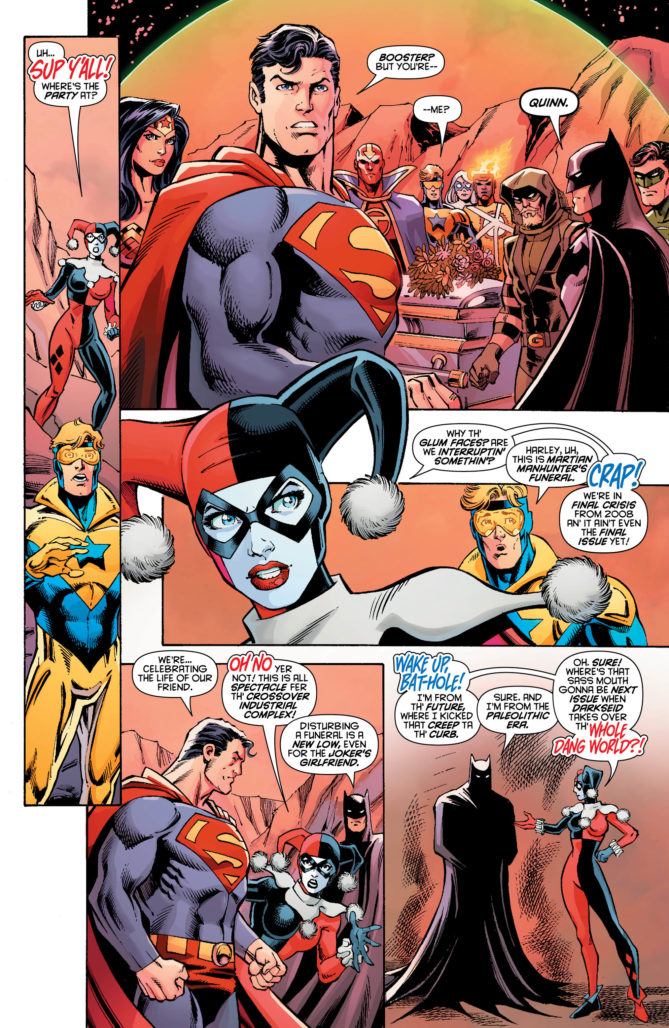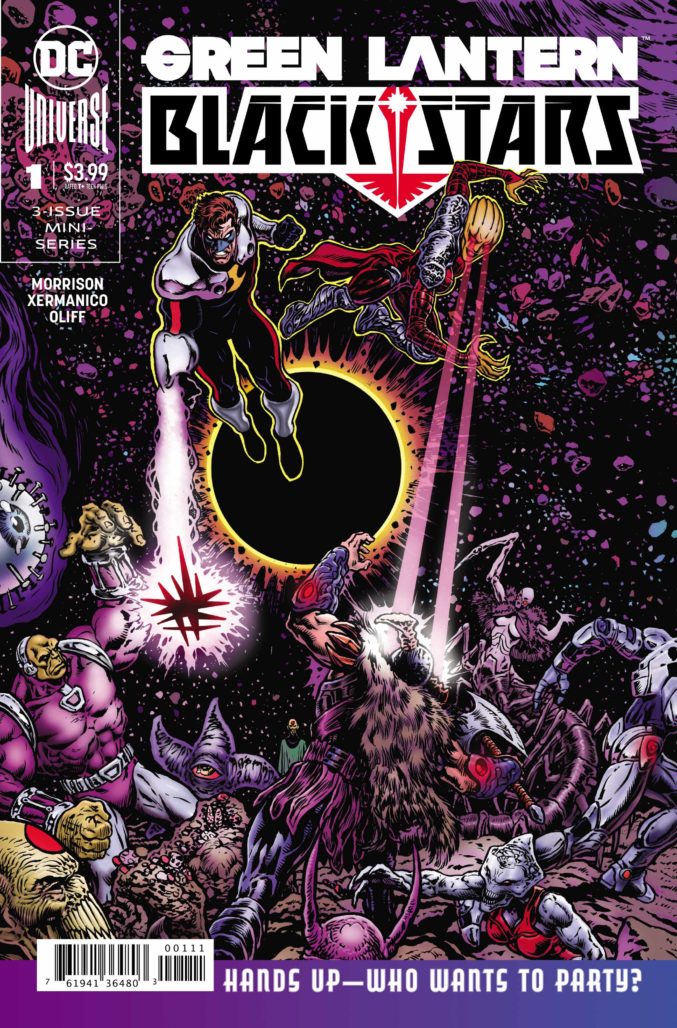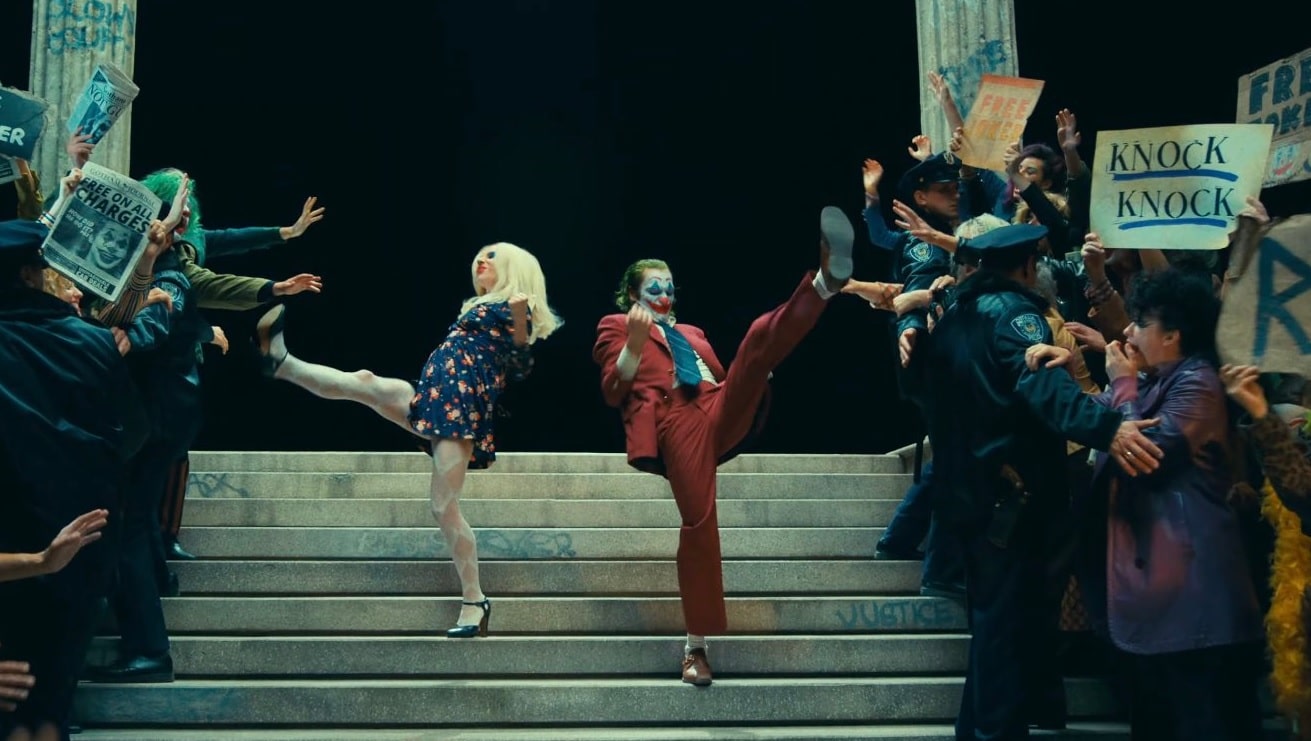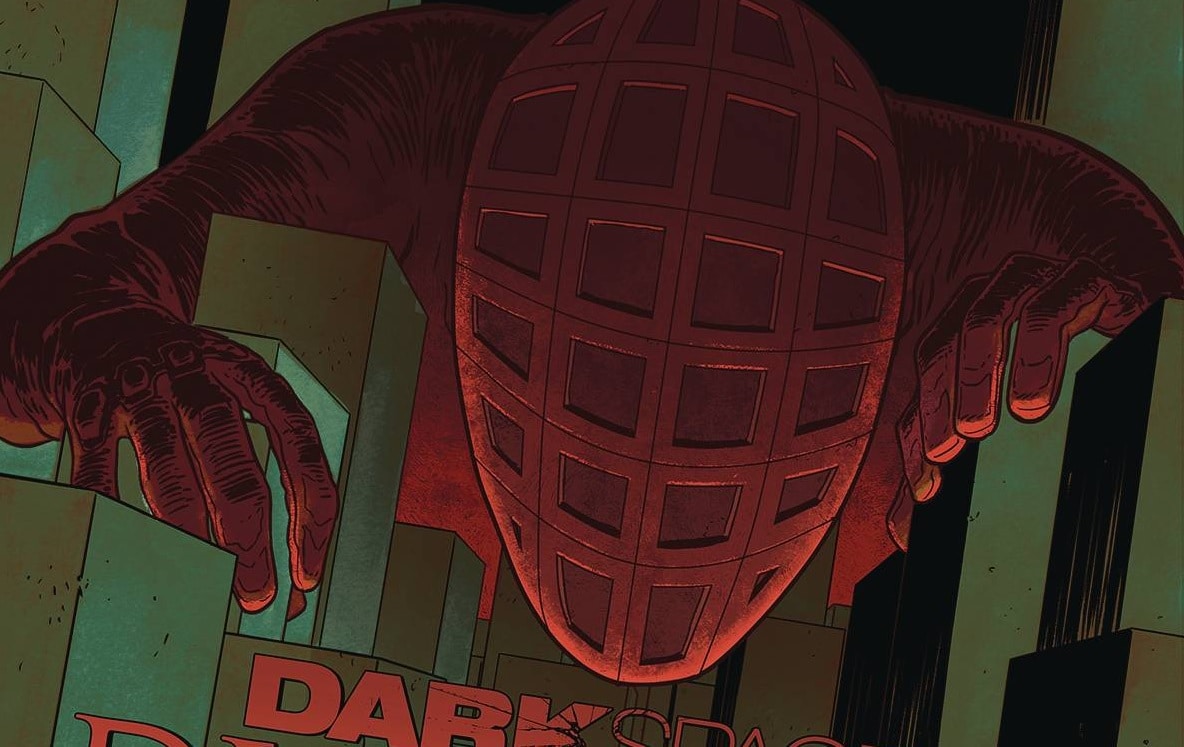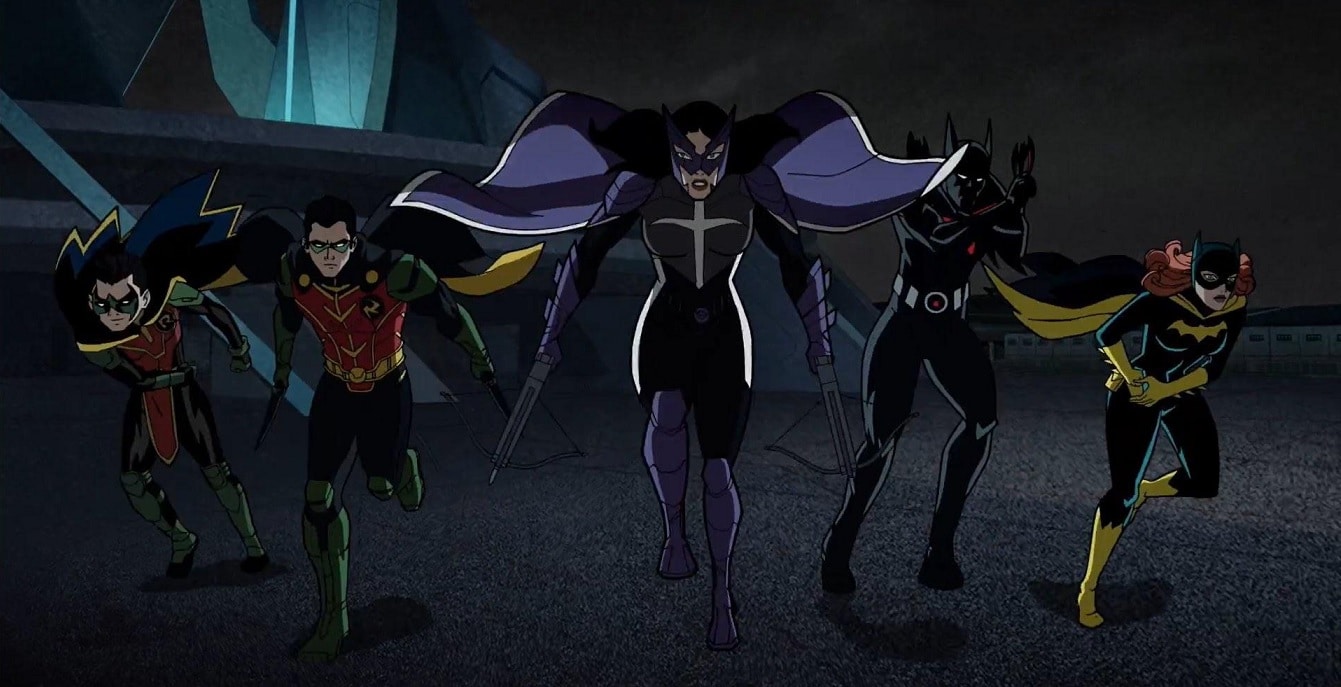THIS WEEK: Harley Quinn takes a madcap trip through an infinity of crises; meanwhile, the Justice League are trying to have a serious crisis over here.
Note: the reviews below contain spoilers. If you want a quick, spoiler-free buy/pass recommendation on the comics in question, check out the bottom of the article for our final verdict.
 Justice League #35
Justice League #35
Writers: Scott Snyder & James Tynion IV
Art: Francis Manapul
Colors: Francis Manapul & Hi-Fi
Letters: Tom Napolitano
If I could only use two words to describe the current Justice League series, they would be nostalgia and expansiveness.
The nostalgia element is obvious if you’ve read Grant Morrison’s JLA series from the 1990’s. Here we have Lex Luthor leading an Injustice Gang (oops, I mean “Legion of Doom”) against the Martian Manhunter and his ‘Big 7’ (nine, really) Justice League. Lex gets his hands on the Worlogog (sorry, “Totality”) that represents all of time and space and the multiverse, and the League must convince all of humanity to band together and fight off the impending loss of hope and freedom before Mageddon (“Perpetua”) comes to claim the universe.
There’s no doubt that Morrison’s JLA is the blueprint upon which this new series is based. But there are some subtle and interesting tweaks that make Snyder’s and Tynion’s story stand out. In the earlier series it was just sort of assumed that humanity would voluntarily rise to face the coming evil. Of course they would. The heroes temporarily granted all of humanity superpowers and then immediately had a willing army of metahumans that lashed out at the threat to end it. In this case, however, humanity is offered a choice between Justice and Doom…and they’re not necessarily choosing the side the heroes expected.
There’s a clever, if not uncomfortable, mirroring of our current times in this story. Luthor and Perpetua are gambling that the citizens of the world are fed up with the status quo and ready to stand up to the so-called good guys in order to grab more power for themselves. To the heroes’ horror, most of the populace is buying into Luthor’s pitch of “Fuck it all, let’s burn this place down,” and refusing the call to listen to their better angels, even as entire worlds are dying as a consequence. Perpetua states plainly in this issue that only those loyal to her will survive the coming war. It all hits kind of close to home. I’m not at all certain this will have a happy ending.
Come to think of it, I’m not sure this story has an ending, period. This isn’t just a self-contained arc that sets up a premise and then resolves it. Justice League builds upon decades of DC lore and world-building, adding a few more puzzle pieces to the overall narrative that changes the way we see those nostalgic past events. We’ve finally learned what the impact of Dark Nights: Metal and No Justice were, and what the Source Wall’s function actually is. We’ve got the Monitor and Anti-Monitor gearing up to go to war once again for the fate of the multiverse. In a very real way, the original Crisis is still playing out.
It’s incredibly interesting to take a step back and look at how DC is positioning this story. Over thirty years ago, DC cooked up an epic worlds-ending Crisis event to completely blow up the shared multiverse and piece it back together in a new, streamlined configuration. When the dust settled, creative teams eagerly dove in to explore this new sandbox and establish the fresh reality for the updated heroes. Then, when things got stale and a bit unwieldy, DC blew it all up again. And again, and again. Crisis events come fast and furious now, with one occurring about every three years or so (Final Crisis in 2008, FlashPoint in 2011, Convergence in 2015, Metal in 2017). The format of these events is mostly formulaic — the core tale is self-contained within a 5-8 issue main series, while 40-50 tie-in issues are scattered across the line. Worlds live, worlds die; Rinse and repeat. It makes sense. These event books are extremely popular and they goose sales whenever they pop up.
But have you noticed something different this time around?
The Justice/Doom saga has spilled into every corner of the DC universe and product line. An entire universe is wiped out of existence in Justice League #35, but not as part of any kind of big event. The entire line has become a Crisis crossover. Just as the Monitor’s spaceship was spotted across various books in the DCU in 1985, so Luthor’s Doom symbol has been recently spotted in every main line book DC has, to help bring readers’ attention to the Very Important happenings in the shared universe. Except there is no crossover. There’s no limited-series event book that gives you the main plot beats in their simplest form. There’s just thirty five issues of Justice League, rolling out the story since last summer. This Crisis event is being told over the course of years, not issues.
Instead of following the same old formula the last time around, DC did something sneaky and new. They introduced Dark Nights: Metal as a world-ending event book — and then never ended it. The DCU is now one big perpetual Crisis crossover with no clear end in sight. The Monitor and Anti-Monitor are locked in a familiar battle with higher and higher stakes. It isn’t a named event and there aren’t any tie-ins. Because everything is a tie-in. Smart money says it will all culminate next year in yet another Crisis event book (which will not end).
Can you even have an ongoing crisis? Isn’t it just called the status quo after a while?
Structural musings aside, Justice League is a fun book that feels important again for the first time since Grant Morrison’s tale of invading White Martians and fifth-dimensional pranksters. It highlights the biggest and best that the DC universe has to offer and takes its rightful place as the centerpiece of the publisher’s line. If you like a longform, expansive story, look no further. This one started a long, long time ago and there’s no end in sight.
Verdict: Buy
 Harley Quinn #67
Harley Quinn #67
Writer: Sam Humphries
Artists: Sami Basri, Dan Jurgens, Norm Rapmund, Aaron Lopresti, Matt Ryan, Tom Derenick, & Trevor Scott
Colorist: Hi-Fi
Letterer: Dave Sharpe
Meanwhile, Harley’s plan is to go back in time and “murderize” the original Crisis. She has event fatigue from all these damn crossovers and tie-ins, and so naturally she grabs Booster Gold and hijacks his time travel doodads to go make it right. Which apparently means that she should make the first Crisis end horribly for the heroes so that the sales for the series tanks and thus ends the grand experiment of blockbuster superhero crossover events forever. It makes sense in her head.
Her noble, if misguided, quest sends Harley and a non-consensual Booster on a road trip tour of the major DCU Crisis events over the years. As they bounce between red-sky events, she tries to talk Superman out of giving rousing speeches and of punching holes in continuity walls and all those things that a Superman does to encourage company-wide crossovers. She horrifies characters with her knowledge of things yet to be and plays spoiler during critical iconic moments. Oh, and it’s a touching Thanksgiving story too.
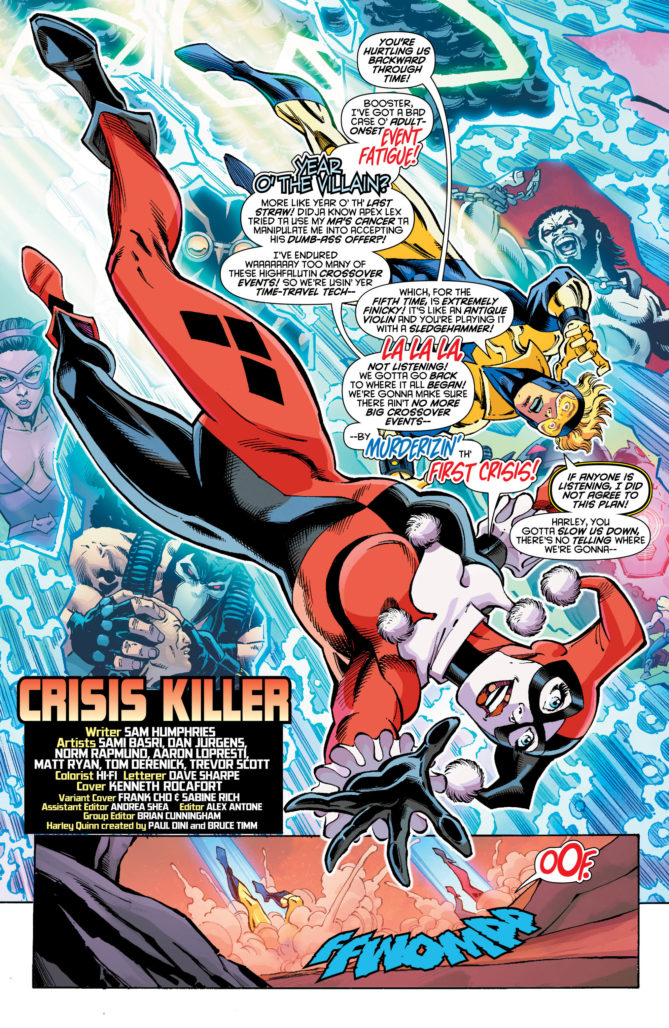
It strikes me that a lot rides on the shoulders of a Harley Quinn creative team. Fans, who have been spoiled with some really great Harley comics over the past several years, have come to expect clever genre-bending meta commentary sprinkled into each issue. No pressure. She’s also become this beloved goofball badass, which is not the easiest tone for a creative team to nail. It’s a big job and it’s impressive how many of these issues really shine.
In Harley Quinn #67, a genius trick is used to bounce between a heartwarming story of Harley visiting her family for the holidays and the epic tale of Harley’s rampaging through the DCU’s biggest inflection points to cause chaos. It’s even difficult to describe in words how they make the transitions between scenes: For a while you’re riding shotgun with Harley on a daring adventure, and on the next page it’s revealed that those were simply panels in a comic book that one of the characters is reading. I mean it’s an in-comic story, inside the comic. See? This is some Inception shit and really hard to convey in prose. There’s layers.
The reader of a Harley Quinn comic is treated more like a studio audience. She can drop character at any moment and speak directly into the camera, Ferris Bueller style. There’s always some on-page gag and Harley always treats the audience like they’re in on the joke. She knows she exists in a comic, knows you’re holding a comic, and knows how many issues it sold. She’s usually peeved at editorial over something. It’s as if Harley can exist both outside the comic and inside it, and can jump freely between states. It’s wild.
When it all comes together, it’s a treat. This issue in particular has a bunch of artists that help recreate the feel of each different Crisis era that Harley visits, getting costumes and attitudes just right for the times. A special mention for the letterer here, Dave Sharpe, who adds a fun visual element. Harley’s speech comes out in different sizes and colors when she wants to emphasize a word or phrase, and the caption bubbles can barely contain her speech. It’s all wrapped up in a tearjerker of a storyline that manages to say what we’re all thinking about DC’s Year of the Villain hoopla.
Harley Quinn #67 would make the perfect gift for someone who knows a lot about DC Comics history and has a sense of humor.
Verdict: Buy
Round-up:
- You know what book seems completely untouchable by any Crisis? Green Lantern. FlashPoint ended the entire multiverse but barely registered a blip in Geoff Johns’ tale in 2011. And now Grant Morrison is off doing his own thing in a dark corner of the universe that doesn’t seem to be particularly beholden to whatever happens in Justice League. As cosmic and far-reaching as Snyder’s event gets, the boys in green will probably keep chugging along with business as usual. You just can’t fix what ain’t broken.
- Except they’re not exactly in green these days, are they? The Darkstars, a sort of cousin group to the Green Lantern Corps, has always been a really interesting concept, especially back in the John Stewart/Donna Troy days. It’s fun to see a new configuration of that group pop up this week in Green Lantern: Blackstars #1, by Morrison and Xermanico. It’s not altogether clear yet why the Lanterns have abandoned their colors to join up with the nefarious Controllers, but it’s always nice to see Mongul get his ass handed to him.
- Hal Jordan is going by the name Parallax again and seemingly up to no good. While I remain a bit leery of the Hal-turned-evil approach, the past year has been a really unique Green Lantern tale and I never want it to end. Go ahead, burn it all down, Hal. We’ll reboot it later.
Miss any of our earlier reviews? Check out our full archive!


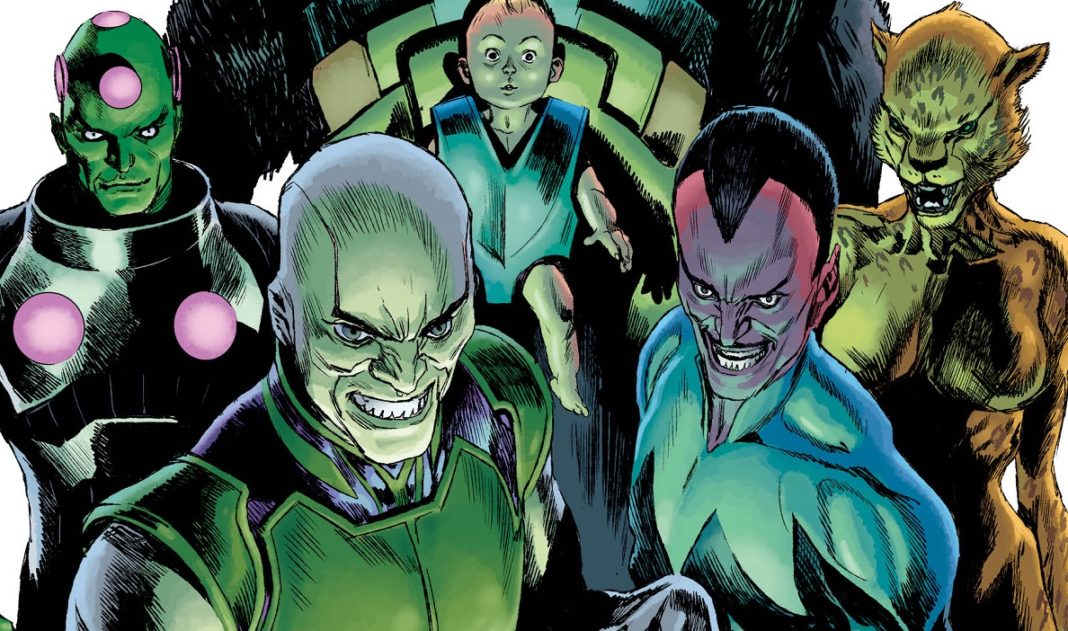
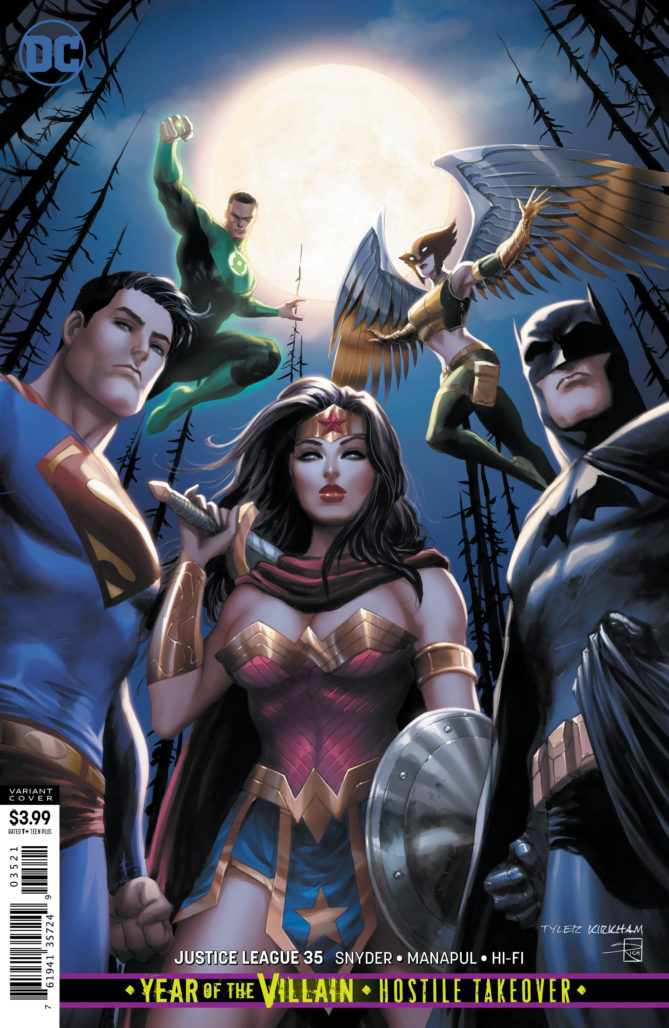 Justice League #35
Justice League #35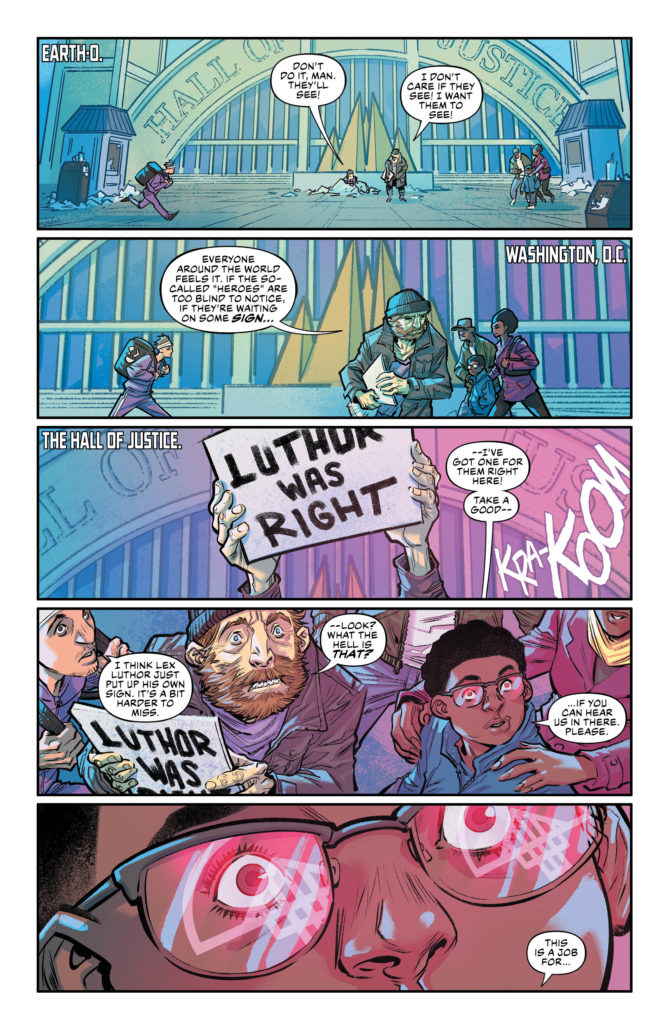
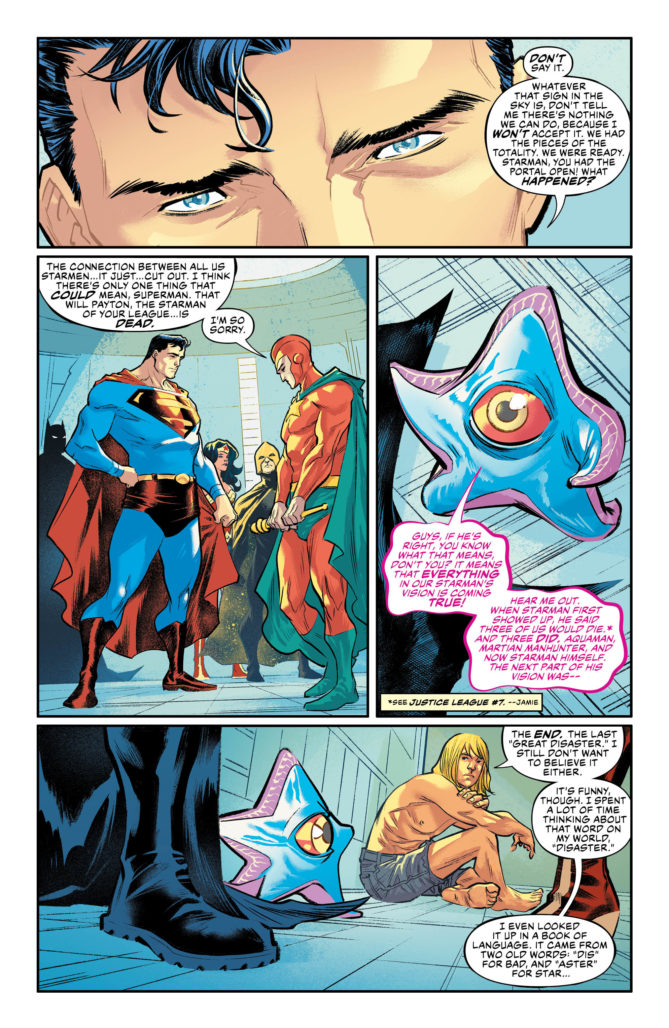
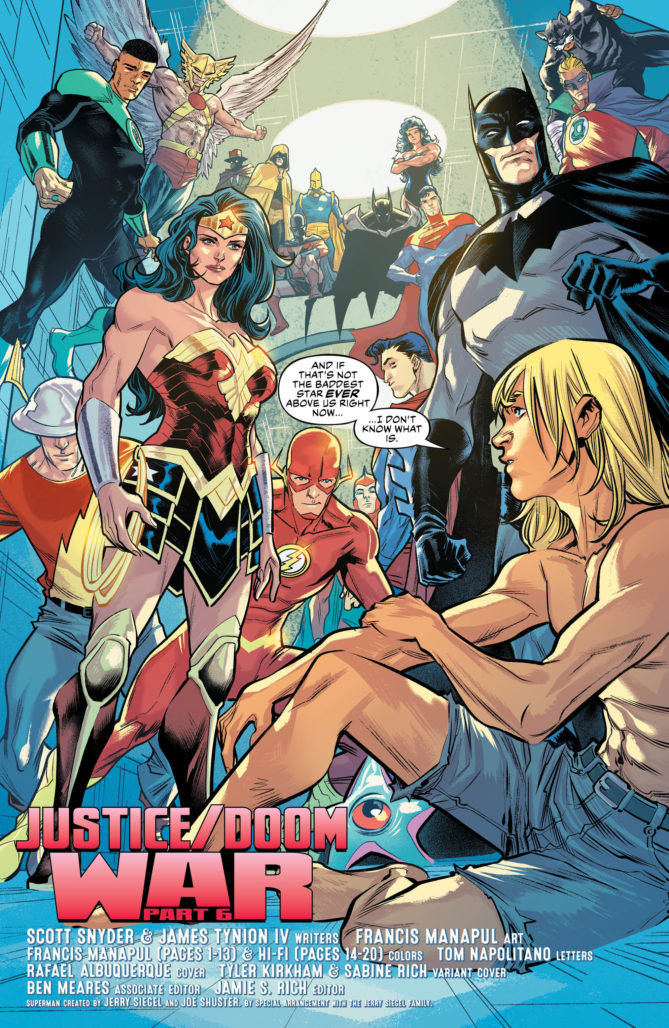
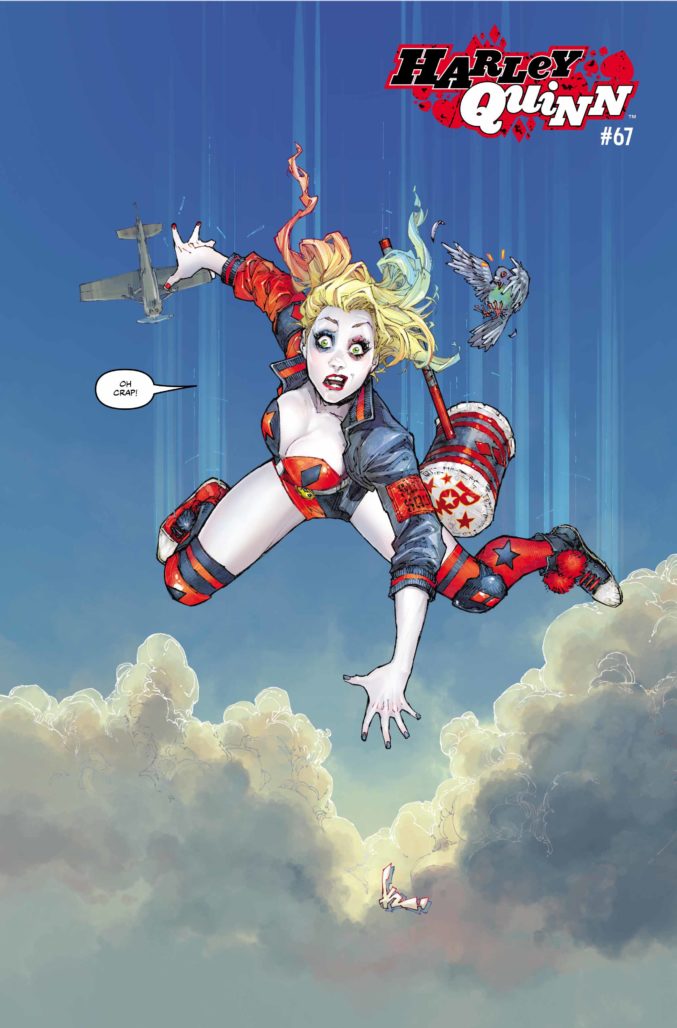 Harley Quinn #67
Harley Quinn #67